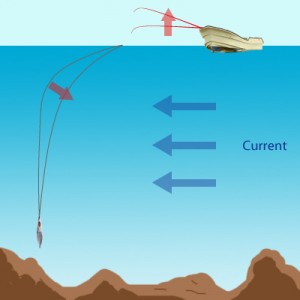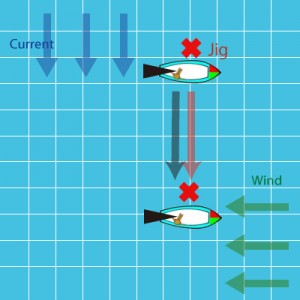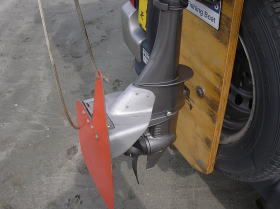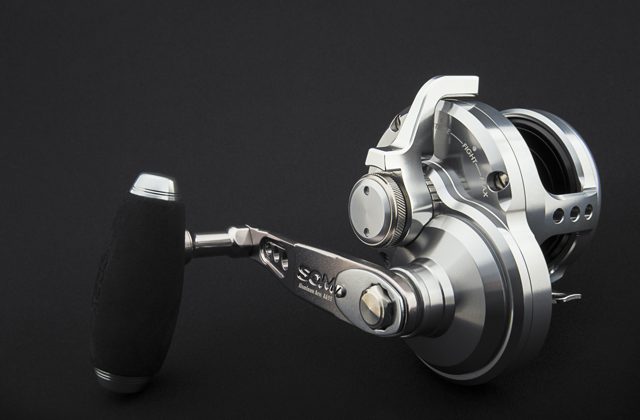Boating to stay vertical
Why does it have to be vertical?
When you have your line going sideways into the water, the whole picture would look like this. The current is pushing the line and you are not in a straight line with your jig. Sometimes you can’t even touch the bottom as the current is pushing the line so much to hang your jig mid-water.
When you try to move the jig with reeling and jerking, you may be just moving the line, and not the jig. Your jig may be just hanging mid-water, something you can never catch a fish with.
Hi-speed jigging would reel in the line so fast and so hard that it can move the jig somehow. But slow-pitch jigging relies on the sequence of small uplifts and falls, and unless you are in a vertical alignment with the jig, the water influence may be canceling all your applications.
In our effort to cut the water influence, we can use thinner line. We can use a heavier jig. In application, the high pitch jerk generates stronger and faster impact to cut through the water influence and move the jig. Also, the long-fall jerk is bigger in motion, better chances to move the jig.
It’s so important to stay in a vertical alignment with the jig to have direct, finesse control of your jig. Staying vertical is a vital point in slow pitch jigging.
How do you drift?
When you drift, your boat is getting 2 kinds of influence, one is the current, one is the wind. On the other hand, your jig is getting only the current influence.
Free-Drifting
The left chart is free drift. The example shows that the current is moving from up to down. The wind is blowing from right to left. You drop a jig in 1 point, the wind and the current together move the boat, mostly the wind, while your jig is influenced by only the current.
It is very hard to do slow-pitch jigging with free drifting. Maybe it works in a minimum wind and minimum current. It’s just so hard because you have to pull up your jig back for so many times.
Drift with Sea-anchor
This is sea-anchor, or parachute anchor. You put in a drogue in the water. The wind pushes the boat, but the drogue puts on a break by catching all the water. It slows down the wind influence and let the boat move with the current, therefore, with the jig.
But you cannot control how much break you put on, and the synchronicity lasts only for certain extent. It’s up to the directions and amounts of wind and current. Also, some small boats have too much buoyancy and shallow draft that the sea-anchor just cannot slow down the wind drift.
Still, the sea-anchor is an effort to stay vertical and a minimum requirement for slow-pitch jigging.
Controlled Drift with Spanker
This is Spanker, a tail sail. Most of Japanese jigging boats have this sail now. It keeps the boat pointing to the wind, a position that catches the least influence by the wind. And a little throttle forward can cancel the wind push. It takes the skills of the captain, but you can actually move with the current.
You can have your line straight down, keeping you in a straight line with the jig, therefore, the direct control of the jig movements.
What is Spanker?

Speed Control
It’s nothing but a lid on the propeller which you can close it to your desired angle. It is a very useful function when you use Spanker. Spanker sets the boat upwind. You set the throttle at the minimum and close this lid to weaken the drive even more, just enough to cancel the wind push. And you can concentrate on your fishing.
Alternative Control Drift
Back Drift
Backing up to the wind is a common method if you have the outboard engine. With stirring and clutching on and off to back up, you can keep the stern to the wind. You can keep watching the line and and the wind to adjust the backing and stay vertical.
If you keep the stern due to the wind, you never know which way the wind tries to turn the boat. Later in the video, he was explaining that you can keep the stern a little bit off-set to the wind so that the wind will try to turn the boat to that side. This way you don’t have to stir right and left hastily. You can keep it one side, when the wind turns the boat, clutch on to back up and turn back to the wind, and keep adjusting to drift with the straight line.
The captain may have to work very busy and, in some conditions, just can’t stay vertical. It may be difficult if you want to do the boating and fishing at the same time.
Front Rudder
Front rudder works just like the spanker sail. It keeps the bow to the wind, and, with clutching on and off forward, you keep stay vertical.
This guy made it electric to lift up and down the rudder, but it doesn’t have to be. It can be done manually with ropes. You just need to make sure you lift it up when you move.

The big fin front keel would work great with the frond rudder, too.
Hope the information helps you! Good luck!
Tags In
Related Posts
13 Comments
Leave a Reply Cancel reply
Categories
- 1. SPJ (57)
- 1-1. Principles (9)
- 1-2. Techniques (11)
- 1-3. Setup (17)
- 1-4. FAQ (19)
- 1-5. Tackles (3)
- 1-6. Video Gallery (2)
- 2. Other Offshore Games (5)
- 3. Fishing Report (105)
- 3-1. Totos (25)
- 3-2. Readers (72)
- 4. Fish Cooking (19)
- 4-1. Iki-Jime (3)
- 4-2. The Art of Sashimi (5)
- 4-3. Recipe (7)
- 4-4. Seasoning (3)
- 5. Fishing Charter (6)
- Fish (12)














This is excellent!!!
Totos do you have any photos or youtube of spankers set up on fishing boats. Is the sail fixed on a mast or is it set up like a kite? Have you seen any small boats with the spanker set up at the front to make better use of deck space?
Our number one problem here is wind. I have a small 1sq/m sail that I may be able to set up as spanker on the boat. I just need to understand how it works it a little better.
Cheers,
Dan
Hi Dan. Glad you liked the post.
I just added some photos of Spanker on the post. Hope it helps. If you can set up Spanker on your boat, that’s probably the first Spankered boat in Australia!
“Perfecter” is probably the most popular car-top fishing boat in Japan. It’s specially designed for fishing with Spanker.
Perfecter
It’s all in Japanese but I’m sure you learn a lot from the photos on this site.
Good luck!
Interesting article, Thank you veru much!
i am very happy with this site. Amount of tips and infos is like nowhere else . Thank you . Where can i buy this or simular type of boat for jigging ?
Gday Totos
Thank you for sharing your knowledge with us. I am learning so much from you. Jigging is becoming popular here in Australia. I fish out of Sydney in 30 to 80 meters using micro jigs of 30 – 40 grams. My success has been limited and I now know why. My best results have come from days when there is little wind to push my small boat along. I tried using a sea anchor which improved my ability to stay in direct contact with my jig but wasn’t the best solution. After reading this great article I will try using my auto pilot bow mount electric motor to combat the influence of the wind against the current. Also I would like to try using larger jigs up to 160grams (max rating for my rod) to help keep my line vertical. Could you please suggest a style of jig that would suit in this weight range.
G’day Bricky, I’m also on the east coast and have the same issue with wind, current. I wouldn’t be too concerned about using a jig that is heavier than what the rod is rated to. I often use jigs that are at least 150% of the max rate on the rod, its just a matter of being conscious of giving the rod a helping hand with the lift. I reckon sometimes you just need to get it down there!
Hi Bricky.
I’m glad my website helps you understand, improve and have more fun! with vertical jigging.
Ben is right. I wouldn’t even worry about the rod rating. Not only the jig weight, it really depends on the water resistance too. If the rod kicks back, that’s good. If it doesn’t kick back, you can switch to long fall. Drop, pick up, one turn, long lift, drop, pick up… Any center-balanced leaf-shaped jigs can do something on the falls.
With Seafloor Control jigs, Spunky, Cranky, Abyss and Arc are fast to fall and work well in currents. Spunky and Cranky work great in uplifts. Abyss and Arc are versatile but they are new jigs and not many weights are available yet.
Gawky is still considered the best fall jig ever. Available in all weights.
Rector is versatile too. Works in uplifts and falls. It’s such an effective jig but it’s slow to fall. (That’s why it’s so effective.) Not really recommended when you are not vertical.
They all work different. You just have to ask the fish which they like!!!
Good luck!
Hi Totos,
Very good article, I am from Australia and currently use a sea anchor, however the idea of a spanker intrigues me. Do you know of any websites or anything that may help me to make or buy one?
Thank you!
Hi James.
I know. If you have the spanker on your boat and you are the only one with ability to stay vertical, you will be devastating.
Yamaha (Japan) has spanker products for small boats. The site is all in Japanese but you can see the pictures.
https://www.ysgear.co.jp/marine/exterior/spanker/
What I suggest to you is to find your local dealer of Yamaha. Talk to them and see if they can help you import it. I’m afraid that I can’t help you on that.
Hello Totos
I may have missed some information, how does anchoring the boat on a reef (60-70m deep) affect slow jigging?? I assume it’s easier to stay vertical on an anchored boat?? Assuming the current is not too strong and the wind direction/speed is roughly constant?!
Regards
Jonathan
Sydney, Australia
Hi Jonathan.
No, no way to stay vertical on an anchored boat. You should think that jigging on an anchored boat would be like shore cast jigging.
Remember the ocean is always moving and your jig is moving with it and your line is being pushed by the move.
Hi Totos
Thank you very much for your excellent posts, I learned a lot from your site.
I am from Egypt. I fish in the red sea, 30 – 70 meters
The wind is usually high, averge 12 Kts, I fish up to 20. I am very interested in slow jigging & practiced it last 3 trips. The boat is 15 meters in length & we do not have sea anchors nor spanks in Egypt.
So I have to choose between free drift with 15 Kts wind where the line will surely be oblique not vertical or classic anchor. I have chosen the later and I get some contacts. Please advice.
Thank you very much & greetings from Egypt.
Hi Sadek.
OK. That’s pretty high winds.
Your boat should be an outboard, right? An outboard boat usually turns away the wind, pointing down the wind. Then you could give a little aft drive to stay vertical? Many people do that if you can somehow maneuver the boat while fishing. You can be creative with ropes if you need extra hand.
Classic anchor? You mean anchoring to the seafloor? That is NOT the way you jig. If you got contacts that way, that’s probably because there was really no current at all or you just happened to come across with hungry passer-by.
Good luck.